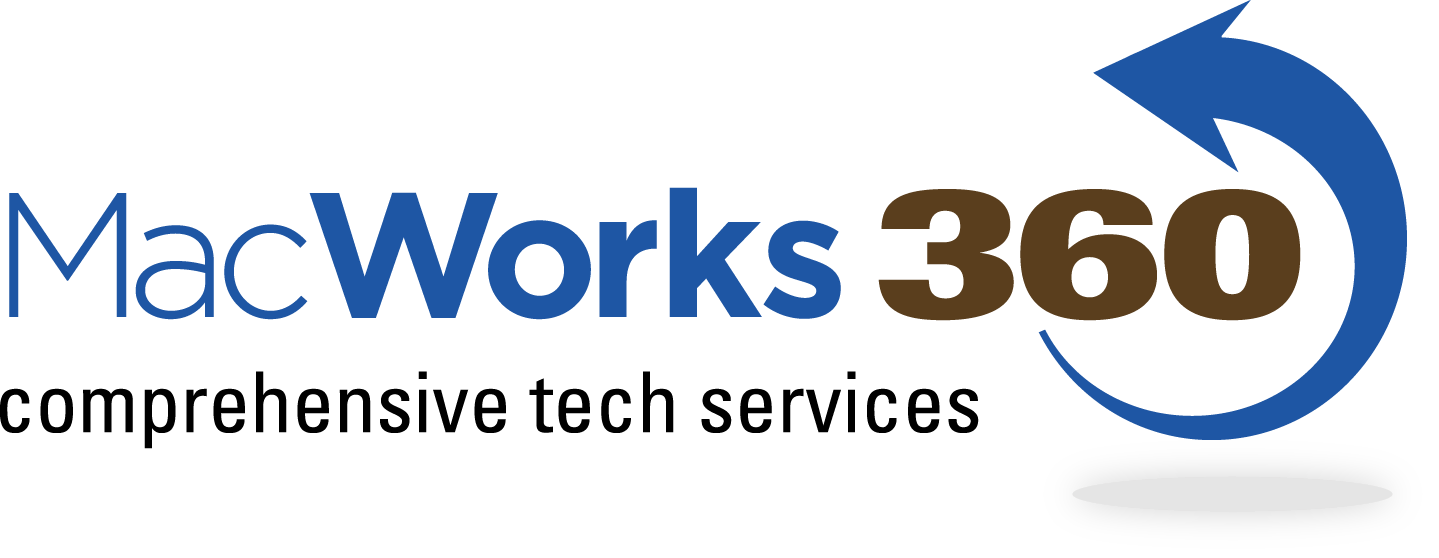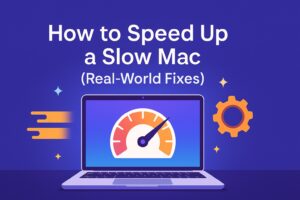How to Speed Up a Slow Mac (Real-World Fixes) | MacWorks 360
How to Speed Up a Slow Mac (Real‑World Fixes)
Fun fact: the original Mac had 8 MHz of CPU power—your watch beats that. If your machine still crawls, use these proven steps to speed up a slow Mac without gimmicks.
Work top to bottom. Measure before and after. Only keep what helps.
Quick Wins (5–10 min)
- Reboot: clears swap and stuck processes. Simple, effective.
- Free space to 20%: macOS slows when the SSD is full. Aim for 20–30% free.
- Close heavy tabs: browsers leak memory; pin essentials and quit the rest.
- External drives: unplug flaky HDDs and hubs that hang Finder.
Diagnose Bottlenecks
- Activity Monitor: sort by CPU, Memory, Energy. Kill obvious hogs you recognize.
- Memory pressure: if it’s yellow/red, you’re RAM‑bound. Quit apps or upgrade the Mac next cycle.
- Disk tab: constant high reads/writes = swap thrash or a misbehaving app.
- Network: slow SMB shares or cloud sync can stall apps; test on local SSD.
Reference: Apple: Activity Monitor
Storage & Cleanup (Safe, Not Snake Oil)
- Manage Storage: → About This Mac → Storage → Manage. Remove big iMovie libraries, old iOS backups, and duplicate exports.
- Downloads & Desktop: move large files to a project folder or NAS. Keep the Desktop light.
- Spotlight & Photos: first‑run indexing can be slow; let it finish before judging performance.
- External NVMe: keep current projects on Thunderbolt NVMe for faster previews/exports.
See also: Synology NAS for Creative Teams
Runaway Apps & Login Items
- Login Items: System Settings → General → Login Items. Remove helpers you don’t need.
- Browser sanity: disable unused extensions. Hardware‑accelerate video.
- Cloud sync: pause during renders/exports; resume after delivery.
- Reset the troublemaker: if one app spikes CPU after updates, trash its cache/preferences (after backing up).
Updates & Health
- macOS updates: install current stable. Performance and security improve together.
- App updates: patch browsers, Adobe/Affinity, video tools weekly.
- Battery health (laptops): low cycle life can throttle. Consider service if it sags under load.
- Spot check SMART: external HDDs with failing SMART cause stalls; replace before disaster.
Reference: Apple macOS updates
Malware & Security
- Run EDR: use reputable Mac endpoint protection. Avoid shady “cleaners.”
- Quarantine odd launch agents: check Login Items and LaunchAgents/Daemons for unknown names.
- Phishing: browser + email filters stop most trouble before it runs.
Guide: Mac Cybersecurity Checklist
Hardware Reality Check
- RAM: constant memory pressure? You’re under‑spec’d. On Apple silicon, buy the right RAM up front next cycle.
- SSD: keep 20–30% free. If you always run near zero, upgrade capacity or offload to NVMe/NAS.
- Thermals: blocked vents cause throttling. Clean dust; give laptops airflow during exports.
- Age: 5+ year Macs slow under modern workloads. Plan a refresh, not endless tuning.
Maintenance Myths (What Not to Do)
- Aggressive “cleaners”: many do harm. Use built‑in tools and reputable utilities only.
- Random PRAM/SMC rituals: rarely fix modern issues. Diagnose first.
- Editing from USB HDDs: they bottleneck. Use internal SSD or Thunderbolt NVMe.
One‑Page “Speed Up a Slow Mac” Checklist
| Area | Action | Status |
|---|---|---|
| Free space | 20–30% SSD free | ☐ |
| Runaway apps | Kill/disable offenders | ☐ |
| Login items | Prune helpers | ☐ |
| Updates | OS stable; apps current | ☐ |
| Malware | EDR scan clean | ☐ |
| Thermals | Clear vents; cool under load | ☐ |
FAQs: How to Speed Up a Slow Mac
Will a clean macOS install help?
Sometimes. Try targeted cleanup first. If issues persist, a clean install plus selective app restore can fix deep cruft.
How much free space is enough?
Keep 20–30% of the internal SSD free for swap, previews, and updates.
Do I need more RAM?
If memory pressure is often yellow/red during your real apps, yes—plan a higher‑RAM model on your next Mac.
Helpful References
Want us to speed up your Mac for you?
MacWorks 360 tunes Macs across New Jersey—storage cleanup, performance profiling, malware checks, and app optimizations. We focus on real‑world gains, not placebo tweaks.
Contact us · Managed IT for Mac · Apple IT Support
Based in Springfield, NJ—serving Summit, Millburn, Short Hills, Chatham, Montclair, and beyond.
Editor’s note: These speed up a slow Mac steps reflect best practices as of August 2025.

